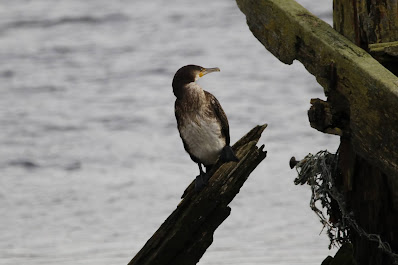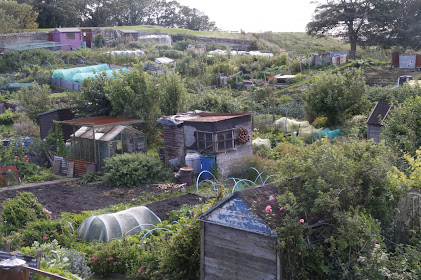SANDERLINGS
During my time in Northumbria I stayed in a cottage on the south shore of the Tweed overlooking the city of Berwick on the other shore. It is a beautiful place, historical, with amazing views, and at times looking out of my window it felt like having my own hide looking over the river. A short walk into town beckoned, and it was easy to get to all its amenities. As a city, Berwick is one of the best for wildlife in the country. Situated on the mouth of a major river it provides the perfect viewpoint from which to observe the animals that share this space with us. Berwick is a beautiful city with many ancient buildings, including having the only complete fortified wall in the UK, looked after by English Heritage, so it begs a least a day to look around in itself. Culture combined with birds.
Berwick across the Old Bridge
Just offshore from Berwick an area of splashing water alerted me to them, and realised they couldn't just be gannets. Running upstairs to gather my binoculars I was in time to see a pod of DOLPHINS just offshore. There were a fair few of them breaking the water to splash a tail down, or to rise up to dive down. It was a magical sight, the best one of my holiday, and all seen from the cottage I was staying in. Soon they moved on and disappeared from view, but they always remain in my memories.
CORMORANT
Also offshore there were GREY SEALS, with SANDWICH and ARCTIC TERNS present in large numbers, they cluster off shore as they disperse from their breeding grounds. There were large numbers of GANNETS, the birds when flying would crash down in to the water for fish, creating little splashes, each time they did it I thought I was seeing more dolphins.
The Lighthouse, Berwick
For birds it is the Tweed that is the main focus. This large river at low tide drains away to leave a vast expanse of rocky tidal mud. As I walked the ramparts of the city walls and then over to the lighthouse, I was able to obtain great views of the birds that feed there. OYSTERCATCHERS, RINGED PLOVER, CURLEW, REDSHANK, TURNSTONE and DUNLIN were all visible from the town.
MUTE SWAN with GOOSANDERS
The most iconic bird of the river is the MUTE SWAN, where a large herd is resident on the Tweed. At times there were different numbers but the most I counted was of 80 birds, at high tide. Also present were large numbers of GOOSANDER, a bird I would see all over the coast, and at this time the males had moulted out of their summer plumage, and now resembled the females. Females of this and like species are called "redheads" for obvious reasons. They were the most common duck in the area present in every coastal place I visited.
The allotments at Berwick
EIDERS, the county bird of NORTHUMBERLAND, were present in relatively small numbers although they were widely distributed. At this time, having finished breeding, the birds disperse out to sea and beyond and are a bit more scarce. As the breeding season has finished the males moult their white plumage and don a more muted blackish colour, while the females remain brown.
Along the Coast Path
Across the river from Berwick is Spittal, a little sea side village with a promenade and a beach. It was quite nice at the end of a day out to explore this area, a short walk from my cottage. The beach at Spittal, despite being busy with sun lovers, held a small flock of 16 SANDERLINGS, feeding along the shoreline like wind-up-toys. There was also a male WHEATEAR amongst some marram grass, a bird that was surprisingly scarce on this holiday. As I walked further down the beach I was able to reach the coast path, which took me from the village of Spittal, up from the beach to headland cliffs, and rocky coves, where, best of all, I was able to see a female peregrine hunting.








No comments:
Post a Comment